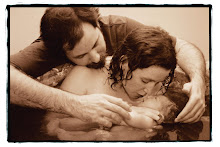In my post, I said:
Many hospitals have been advising all laboring women to not eat or drink during labor in case they need emergency surgery with general anesthesia. But isn't that kind of like advising everyone to skip breakfast in case they get hit by a bus?
Molly's comment:
Are the chances of having an emergency C-section really comparable to getting hit by a bus? I've definitely heard of more C-sections than I have bus accidents in the past...My reply:
Sure, Molly - the chances of having a labor culminate in a cesarean are, possibly, higher than having a random accident (edited to add: I'm guessing here - a less lazy/busy person might add some statistics - chime in if ya got 'em!). However, I think it's VERY important to differentiate between unplanned cesareans and true emergency cesareans. Many woman will call their unplanned cesareans "emergency" when in fact they were actually unplanned and while there was perhaps not an easy-breezy pace, there was likely time for regional anesthesia. I have, luckily, been a part of only one true emergency cesarean in about 400 births.
As I said, the chances of needing energy for labor is 100%...and not having sufficient energy can actually lead to unnecessary cesareans if the laboring woman is unable to carry on or her labor stalls and augmentation of that labor leads to fetal distress. Avoidable cesareans (major abdominal surgeries) pose risks to moms and babies. So the extremely small risk posed by eating in labor is, in my opinion, worth it.
Coincidentally, an OB from a respected hospital in Boston recently quoted in the NY Times used a very similar example and line of reasoning to my bus idea, so I'm comfortable with my statement. I'll post this in a blog entry & try to find the NY Times article too. Thanks for your important question.
best,
Kim
And that NY Times article can be found here if you would like to read the whole thing - there is a good discussion of what all the fuss is about, concern-wise - it is serious, and it's very, very rare. The quote I mentioned:
“My own view of this has always been that you could say one shouldn’t eat or drink anything before getting into a car on the same basis, because you could be in an automobile accident and you might require general anesthesia,” said Dr. Marcie Richardson, an obstetrician and gynecologist at Harvard Vanguard Medical Associates in Boston, who was not connected to the new study.













2 comments:
Well put Kim.
My thinking, has always been - as a former EMT - I definitely do NOT want to be in a medical institution that cannot handle a belly "full" of what will most likely be light labor foods for "emergency" anesthesia. If they can't deal with that I don't want to be there. Every day the ER deals with much more complex cases that come through their doors needing general anesthesia - and those folks more often than not just ate a full meal.
In addition - if you do vomit you are less likely to damage your lungs if you don't aspirate pure bile!
The only true "emergency" cesarean I ever attended had time for a spinal to be placed - so even that mother did not have general anesthesia. An accomplished anesthesiologist can place a spinal in a two minutes or less - the same amount of time as general.
However - I do understand the fear and have heard doctors use it to manipulate laboring women to follow orders by threatening dead babies (honest to God). So I can see how any deviation can cause an uproar. Sigh.
Thanks Luna - good points also. And that one emergency cesarean I was a part of also had some intuition of a problem & had opted to get an epidural moments prior - not because of pain. I was part of one cesarean where general was used b/c of a suspected but untested allergy issue.
Post a Comment